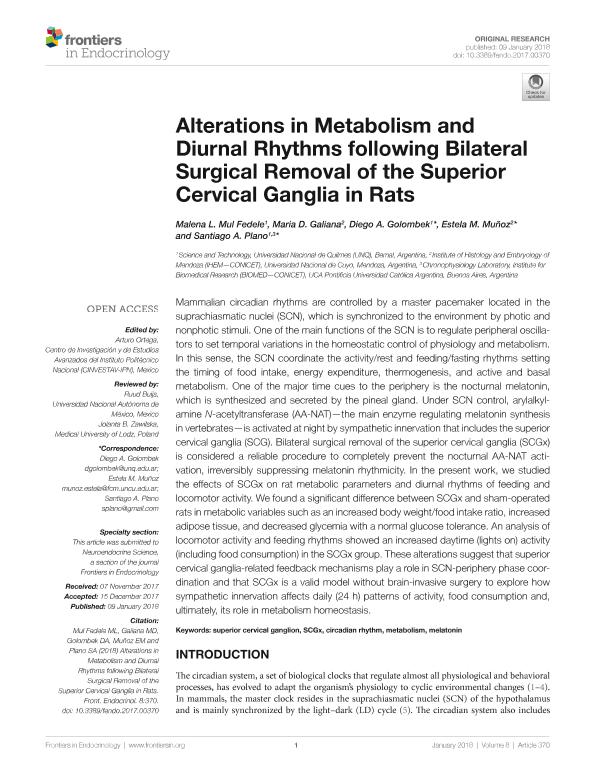Artículo
Alterations in Metabolism and Diurnal Rhythms following Bilateral Surgical Removal of the Superior Cervical Ganglia in Rats
Mul Fedele, Malena Lis ; Galiana, Maria D.; Golombek, Diego Andrés
; Galiana, Maria D.; Golombek, Diego Andrés ; Muñoz, Estela Maris
; Muñoz, Estela Maris ; Plano, Santiago Andrés
; Plano, Santiago Andrés
 ; Galiana, Maria D.; Golombek, Diego Andrés
; Galiana, Maria D.; Golombek, Diego Andrés ; Muñoz, Estela Maris
; Muñoz, Estela Maris ; Plano, Santiago Andrés
; Plano, Santiago Andrés
Fecha de publicación:
01/2018
Editorial:
Frontiers Media SA
Revista:
Frontiers in Endocrinology
ISSN:
1664-2392
Idioma:
Inglés
Tipo de recurso:
Artículo publicado
Resumen
Mammalian circadian rhythms are controlled by a master pacemaker located in the suprachiasmatic nuclei (SCN), which is synchronized to the environment by photic and nonphotic stimuli. One of the main functions of the SCN is to regulate peripheral oscillators to set temporal variations in the homeostatic control of physiology and metabolism. In this sense, the SCN coordinate the activity/rest and feeding/fasting rhythms setting the timing of food intake, energy expenditure, thermogenesis, and active and basal metabolism. One of the major time cues to the periphery is the nocturnal melatonin, which is synthesized and secreted by the pineal gland. Under SCN control, arylalkylamine N-acetyltransferase (AA-NAT)-the main enzyme regulating melatonin synthesis in vertebrates-is activated at night by sympathetic innervation that includes the superior cervical ganglia (SCG). Bilateral surgical removal of the superior cervical ganglia (SCGx) is considered a reliable procedure to completely prevent the nocturnal AA-NAT activation, irreversibly suppressing melatonin rhythmicity. In the present work, we studied the effects of SCGx on rat metabolic parameters and diurnal rhythms of feeding and locomotor activity. We found a significant difference between SCGx and sham-operated rats in metabolic variables such as an increased body weight/food intake ratio, increased adipose tissue, and decreased glycemia with a normal glucose tolerance. An analysis of locomotor activity and feeding rhythms showed an increased daytime (lights on) activity (including food consumption) in the SCGx group. These alterations suggest that superior cervical ganglia-related feedback mechanisms play a role in SCN-periphery phase coordination and that SCGx is a valid model without brain-invasive surgery to explore how sympathetic innervation affects daily (24 h) patterns of activity, food consumption and, ultimately, its role in metabolism homeostasis.
Palabras clave:
CIRCADIAN RHYTHM
,
MELATONIN
,
METABOLISM
,
SCGX
,
SUPERIOR CERVICAL GANGLION
Archivos asociados
Licencia
Identificadores
Colecciones
Articulos(IHEM)
Articulos de INST. HISTOLOGIA Y EMBRIOLOGIA DE MEND DR.M.BURGOS
Articulos de INST. HISTOLOGIA Y EMBRIOLOGIA DE MEND DR.M.BURGOS
Articulos(OCA HOUSSAY)
Articulos de OFICINA DE COORDINACION ADMINISTRATIVA HOUSSAY
Articulos de OFICINA DE COORDINACION ADMINISTRATIVA HOUSSAY
Articulos(SEDE CENTRAL)
Articulos de SEDE CENTRAL
Articulos de SEDE CENTRAL
Citación
Mul Fedele, Malena Lis; Galiana, Maria D.; Golombek, Diego Andrés; Muñoz, Estela Maris; Plano, Santiago Andrés; Alterations in Metabolism and Diurnal Rhythms following Bilateral Surgical Removal of the Superior Cervical Ganglia in Rats; Frontiers Media SA; Frontiers in Endocrinology; 8; 1-2018; 1-10
Compartir
Altmétricas



